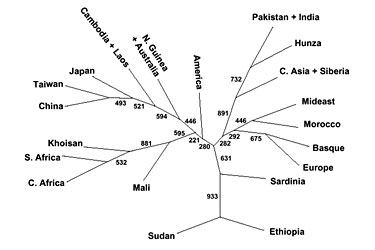November 12, 2000
By Diane Kightlinger,
Nov. 6, 2000 — A study of mutations in the Y chromosome confirms the theory that modern humans originated in Africa and then spread out across the world. More significantly, the study proves the Y chromosome, which all men inherit from their fathers, to be a powerful tool for following human migration.
Peter Underhill of Stanford University and his colleagues based their conclusions on detailed analysis of DNA from more than 1000 men in 22 different geographic areas. Their work appears in the current issue of Nature Genetics.
How can DNA from men alive today reveal their ancestors' travels through the ages? The researchers found 87 new genetic markers that helped them follow the inheritance pattern of Y chromosome mutations, or variations. Markers signal the location of a gene, allowing scientists to trace a gene and its mutations.
Y-Chromosome Tree

This tree of lineages shows the most likely relationship among men around the
world based on their Y chromosome type. The roots of the tree show the
African origin of our species, and a common male ancestor 59,000 years ago.
"Each branch of the tree is defined by a new mutational event," Underhill said.
In other words, mutations in the Y chromosome tell us where modern man went after he left Africa, carrying elements of the original gene pool with him.
For example, a trio of mutually reinforcing mutations occurred early in the dispersal of man. "Most of the men in the world, myself included, have those three mutations," said Underhill. The only exceptions: African men.
The ancestors of men with the mutations apparently took part in the initial expansion of humans from Africa to Asia about 44,000 years ago. But the DNA of the African men shows a direct tie to our common paternal ancestor — the figurative "Adam" who lived 59,000 years ago — at the root of Underhill's tree.
What's remarkable is just how strongly the genetic distance between men, as shown on the tree, reflects their geographic location. Traveling up the tree trunk and along one main branch leads to a mutation shared by all Asian men — but no others. Keep climbing and eventually the twigs distinguish between Japanese and Chinese chromosomes.
"The Y chromosome begins to develop a finer detail for the subsequent phases," said Prof. Colin Renfrew of the McDonald Institute for Archaeological Research at Cambridge.
He noted that Underhill's tree supports an early migration along the south coast of Asia, then across the sea to New Guinea and Australia. That evidence combats the theory of an independent origin for aboriginal peoples.
Back to Science Home